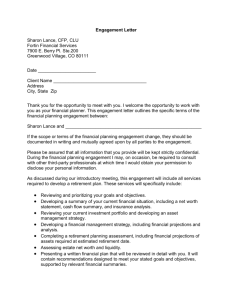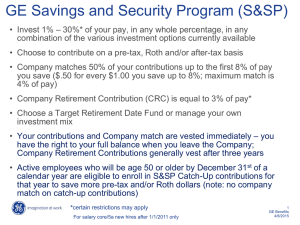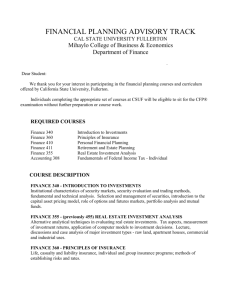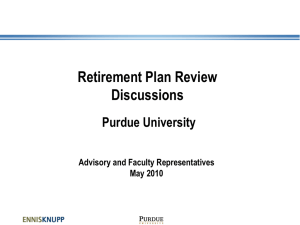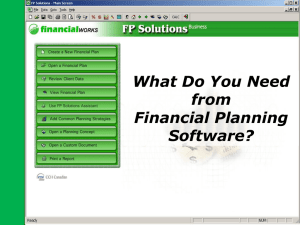Part 1 - CFP Board
advertisement
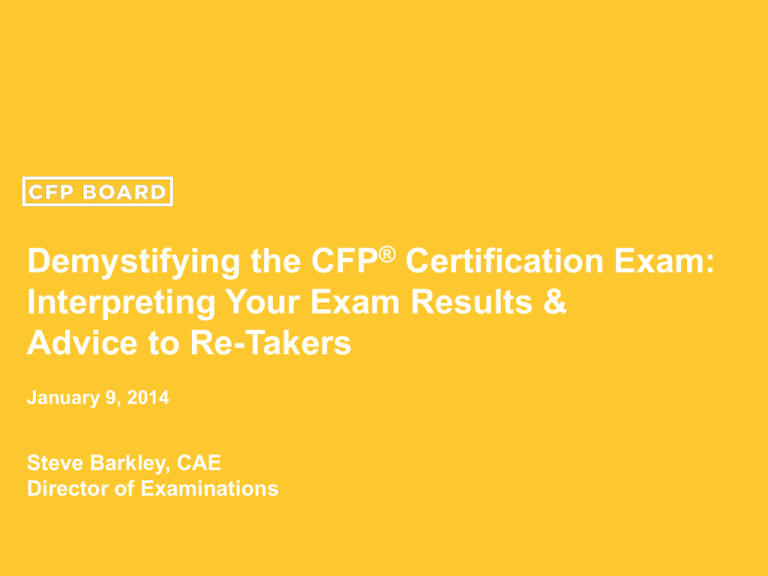
Demystifying the CFP® Certification Exam: Interpreting Your Exam Results & Advice to Re-Takers January 9, 2014 Steve Barkley, CAE Director of Examinations Webinar Outline ■ Part 1: Explanation of Exam Reports Domain Level Topic Level ■ Part 2: How the Reports Can Guide Your Study Plan ■ Part 3: Suggestions for Re-takers Part 1 Explanation of Domain and Topic-Level Reports Two Types of Exam Diagnostics ■ Domains (Exam blueprint) Job Task focused ■ Principal Topics (Supplemental report) Content focused CFP® Certification Examination Eight Major Domains 1. Establish and Define the Client Relationship (8%) 2. Gather Information Necessary to Fulfill the Engagement (9%) 3. Analyze and Evaluate the Client’s Financial Status (25%) 4. Develop the Financial Planning Recommendation(s) (25%) 5. Communicate Financial Planning Recommendation(s) (9%) 6. Implement the Financial Planning Recommendation(s) (9%) 7. Monitor Financial Planning Recommendation(s) (5%) 8. Practice Within Professional and Regulatory Guidelines (10%) Domain Level Diagnostic Principal Topics 1. General Principles of Financial Planning 2. Insurance Planning 3. Investment Planning 4. Income Tax Planning 5. Retirement Planning 6. Estate Planning 7. Interpersonal Communication 8. Professional Conduct and Fiduciary Responsibility Percentage of Exam by Topic Areas Topic Level Diagnostic Example of Domain and Topic Reports ■ A look at one candidate who was close to passing… Domain Report Topic Report Part 2 Using Domain and Topic-Level Reports to Prepare Study Plan How to Develop a Study Plan Balance areas of weakness with percentage of exam coverage. TOPICS ■ Sub-topics in areas of relative weakness. DOMAINS ■ Job Tasks in areas of relative weakness. Sample of Topic Breakdown ■ Retirement Planning 44. Retirement needs analysis 45. Social Security (Old Age, Survivor, and Disability Insurance, OASDI) 46. Types of retirement plans 47. Qualified plan rules and options 48. Other tax-advantaged retirement plans 49. Regulatory considerations 50. Key factors affecting plan selection for businesses 51. Investment considerations for retirement plans 52. Distribution rules, alternatives, and taxation Sample Domain Breakdown Domain 3- Analyze and Evaluate the Client’s Status (25%) A. Evaluate and document the strengths and vulnerabilities of the client’s current financial situation 1. Financial status a. Statement of financial position/balance sheet b. Cash flow statement c. Budget d. Capital needs analysis (e.g., insurance, retirement, major purchases) 2. Risk management and insurance evaluation a. Insurance coverage b. Retained risks c. Asset protection (e.g., titling, trusts, business form) d. Client liquidity (e.g., emergency fund) 3. Benefits evaluation a. Government benefits (e.g., Social Security, Medicare) b. Employee benefits 4. Investment evaluation a. Asset allocation b. Investment strategies c. Investment types 5. Tax evaluation a. Current, deferred and future tax liabilities b. Income types c. Special situations (e.g., stock options, international tax issues) Part 3 General Suggestions to Re-takers What if I Did Not Pass? When Should I Retake? Factors to Consider: ■ How strong was your exam performance? ■ How much time do you have available to schedule preparation? ■ Have you had repeated unsuccessful attempts? Prepare a Study Plan Be Aware of Human Nature Most of us tend to… 1) Study things we like or in which we already have strengths and 2) AVOID things we don’t like or are NOT as strong If You Have Failed the Exam More Than Once… ■ Be honest with yourself ■ How much time invested? Different Results Require Different Preparation If you are not successful at something, and continue to prepare in the same way, DO NOT expect a different outcome. Insanity: doing the same thing over and over again and expecting different results. Engage Others ■ Find a study partner/form a study group ■ Talk to others who were successful ■ Seek a mentor “How do you get to Carnegie Hall?” Practice, practice, practice. Sources for Practice Exam Questions: Textbooks Review course materials CFP Board sample items Learning Objectives Resource Document ■ www.CFP.net/learning-objectives-resource-document You CAN Do This. Resources ■ Steven Barkley, CAE Director of Examinations SBarkley@cfpboard.org 202-379-2233 ■ examinations@cfpboard.org Questions?
